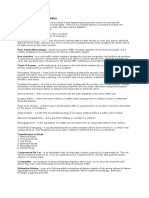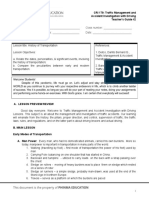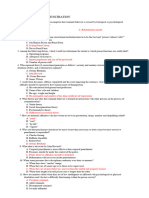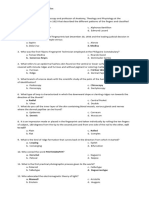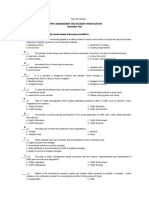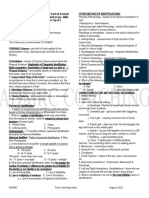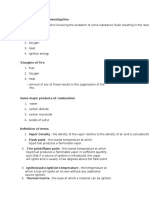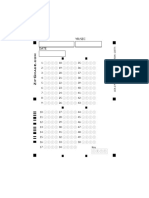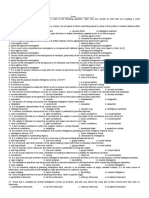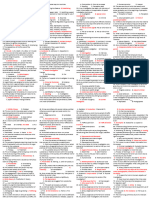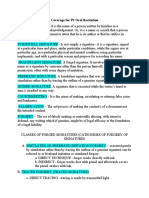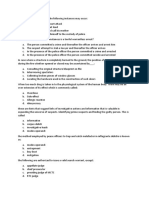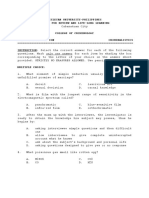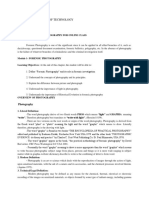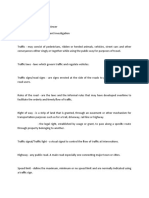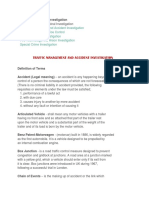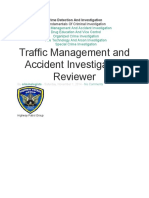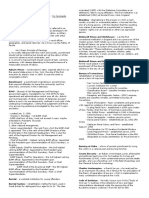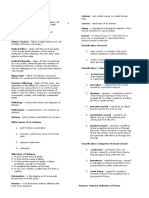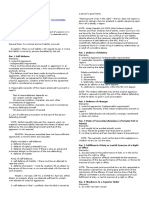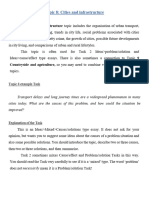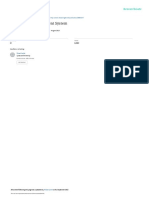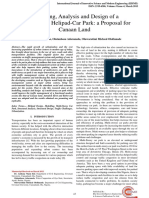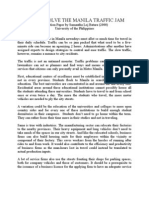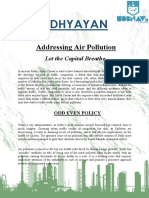Traffic Operation and Accident Investigation
Uploaded by
Randal's CaseTraffic Operation and Accident Investigation
Uploaded by
Randal's CaseTraffic Operation and Accident Investigation
Traffic - may consist of pedestrians, ridden or herded
animals, vehicles, street cars and other conveyances
either singly or together while using the public way for
purposes of travel.
Traffic laws - laws which govern traffic and regulate
vehicles.
Traffic signs/road signs - are signs erected at the
side of the roads to provide information to road users.
Rules of the road - are the laws and the informal
rules that may have developed overtime to facilitate
the orderly and timely flow of traffic.
Right of way - is a strip of land that is granted,
through an easement or other mechanism for
transportation purposes such as for a trail, driveway,
rail line or highway.
- the legal right, established by usage or
grant, to pass along a specific route through property
belonging to another.
Skid mark - is the mark a tire makes when a vehicle
wheel stops rolling and slides or spins on the surface of
the road.
Traffic signal/Traffic light - a visual signal to control
the flow of traffic at intersections.
Highway - any public road. A main road especially one
connecting major town or cities.
Speed limit - define the maximum, minimum or no
speed limit and are normally indicated using a traffic
sign.
1.
Traffic accident - occurs when a vehicle collides with
another vehicle, pedestrian, animal, road debris or
other statutory obstruction such as tree or utility pole.
2.
Causes of traffic accidents
1.
2.
3.
4.
5.
Human factors - ex. driver behavior, visual
and auditory acuity, intoxication,decision
making ability and reaction speed.
Motor vehicle speed.
Driver impairment - factors that prevent the
driver at their normal level of skill. Common
impairment include, 1) alcohol use 2) physical
impairment - ex. poor eyesight 3) youth teens and early twenty aged drivers have the
highest incidence of both accidents and
fatalities among all driving age group. 4) old
age 5) sleep deprivation/fatigue 6) drug use including prescription drug.
Road design
Vehicle design and maintenance
seat belts - wearing seat belts reduces the risk
of death by two thirds.
maintenance - a well designed and maintained
vehicle with good breaks, tires and well
adjusted suspension will be more controllable
in an emergency and better equipped to avoid
collision.
skid marks are caused by rubbers deposited
on the road.
one form of trace evidence, when their size
and shape can reveal much about the vehicle
speed and forces of acceleration or
deceleration.
the length of the skid mark is closely related
to the vehicle speed at the instant of breaking,
measuring the marks yields an estimate of
original speed.
Locard exchange principle - was postulated by
Edmong Locard in the 20th century which
states that with contact between two items,
there will be an exchange. Every contact
leaves a trace. Everywhere you go, you take
something with you and you leave something
behind.
Skid mark are divided into:
Hit and run - is the act of causing a traffic accident
and failing to stop and identify oneself afterwards.
Mary Ward - worlds first road traffic death including a
motor vehicle, is alleged to have occurred on august
31, 1869, when she fell out of her cousins steam car
and was run over it.
center of gravity - roll overs have become
common due to increased popularity of taller
SUV and minivans which have a higher center
of gravity than standard passenger car.
motorcycles - have little protection.
3.
acceleration marks - created on acceleration
if the engine provides more power that the tire
can transmit.
braking marks - if the brakes "lock-up" and
cause the tire to slide.
yaw marks - if the tire slide sideways.
RA 4136 - Land Transportation and Traffic code of the
Philippines.
Coefficient of Friction - is a dimensionless scalar
value which describes the ratio of the force of friction
between two bodies and the force pressing them
together.
Rail Adhesion - grip wheels of a train have on the
rails.
Split Friction - dangerous condition arising due to
varying friction on either side of a car.
Road Texture - affects the interaction of tires and the
driving surface.
Profilograph - devised used to measure pavement
surface roughness.
Tribometer - an instrument that measures friction on
a surface.
Traffic Waves - "stop waves" "traffic Shocks" - are
traveling disturbances in the distribution of cars on a
highway.
Traffic Flow - the total number of vehicles passing a
given point in a given time. Traffic flow is expressed as
vehicle per hour.
Traffic Congestion - "traffic jam" - is a condition on
roads, streets or highways that occurs as use increases.
Characteristics of Traffic Congestion
1. Slow speed of vehicles
2. Longer travel time
3. Increased vehicle queuing
Classical Theories of Traffic Flow
1. Free flow
2. Congested traffic
Three-Phase Traffic Theory - is an alternative theory
of traffic flow developed by Boris Kerner between 1996
and 2002.
1. Free flow
2. Synchronized flow
3. Wide moving jam
Pedestrian - is a person traveling on foot whether
walking or running.
Gridlock - a traffic jam so bad that no movement is
possible.
China - (Beijing-Zhangjiakou province) - is considered
the worlds worst traffic jam ever as traffic congestion
stretched more than 100 kilometers including 11 days
of gridlock.
Brazil - (Sao Paolo) - has the worlds worst daily traffic
jams.
France - (A6 Auto-route) - between Paris and Lyon
was considered the worlds longest traffic jam.
Traffic Operation Definition of Terms
Abrasion - a condition manifested in pavement
markings by gradual surface erosion, thinning, and
disappearance of the film due to wind, water, sand, and
vehicle tire wear.
Acceleration - a rate of change of speed resulting in
an increase in travel speed.
Acceleration lane - a speed change lane for the
purpose of enabling vehicle entering a roadway to
increase its speed to a rate at which it can safely merge
with through traffic, providing the necessary merging
distance, and giving the main road traffic the necessary
time to make appropriate adjustment.
Acceleration marks - marks that are just opposite the
skid marks.The tires are being rotated by the axle and
when done fast enough, the outside of the tire, the
thread, takes time to catch up to the rest of the tire,
which is being held by the coefficient of friction
between the tires and the road surface.Therefore, the
acceleration marks are heavy at the beginning and
lighten up as the tire thread catches.
Access - a way of entering or traveling towards a
location.
Actuation - the operation of a detector in registering
the presence or passage of a vehicle or pedestrian.
Advance warning area - the first component of a
work zone, upstream of the approach area, used to
alert drivers to road work ahead.
Advisory maximum speed - an advisory speed
posted when the roadway geometries result in a
maximum safe speed which is 20 km/hr or more below
the operating speed and is 10 km/hr or more below the
regulatory speed limit.
Advisory speed - the speed, determined to the
nearest 5 km/hr at which traffic may safely negotiate a
potential hazard under favorable driving conditions.
A.I.D. - automatic incident detection.
Anti lock breaking system - (ABS) breaking system
designed to break to break the vehicle in the most
effective manner, without locking up the tires and
causing the tires to go into a skid.This system is used
differently than standard breaks when breaking in an
emergency situation.The break pedal is stepped on and
held in place while the electronic system takes over and
modulates or applies the brakes until the wheels want
to lock up and then releases and breaks again.
Base drawing - The scale drawing made of the
accident scene that shows all the landmarks and detail
to set the scene. It generally does not contain any
measurements or any points of impact (POI) or points
of rest (POR)
Bottleneck - a highway section with reduced capacity
that experiences operational problems such as
congestion.
Boulevard - an improved strip of land between the
roadway and the sidewalk or between two opposing
roadways.
Bull nose - the area or point of divergence between
two diverging roadways such as between free way
mainline lanes and an exit ramps.
Bumper fracture - fractures that typically occur due
to the impact of a vehicle on the calves of a decedent
with fractures of the tibia or fibula.They may be
unilateral or lateral.
Call box - a telephone pr other communications device
located a given locations along the side of the
freeway.Motorists can request various services such as
police, fire, or ambulance by pressing certain buttons or
using voice communications.
Carbon dioxide - a molecule consisting of one atom
of carbon and two atoms of oxygen,which is a major
combustion product of the burning of organic
materials.Carbon dioxide is the result of complete
combustion of carbon.
Carbon monoxide - a colorless, odorless, very toxic
gas formed by burning carbon or organic fuels.A
gaseous molecule having the formula CO, which is the
product of incomplete combustion of organic materials.
Carpool - an arrangement in which a group of people
share the use and possibly the cost of a car in traveling
to and from pre-arrange destinations together.
Causeway - a bridge or raised way constructed over
marshy land or water.It may be either an earth fill or
bridge type structure.
Center lane facility - a reserved lane at or near the
center of the roadway.
Chemical etching - a form of texturing a mold
utilizing an acid bath that erodes selective portion of
the metal, leaving a resulting texture or pattern.
Chicane - a series of curb extensions on alternating
sides of a roadway, which narrow a roadway and
requires vehicle to meander to travel through the
chicane. Typically, a series of three curb extensions is
used.
Chop shop - a location, often an automobile repair
shop or salvage yard, where a stolen car is stripped of
its parts (radio,doors,engine,etc) the remains are cut
up and sold for scrap metal.
Citation - a ticket issued by an officer deputized by the
LTO for violating traffic laws.
Collision - an incident resulting in property damage,
personal injury or death, and involving the loss of
control and/or the striking of one or more vehicles with
another vehicle, person, an animal, or an inanimate
object.
Collision,primary - the impact between and another
vehicle or a vehicle and a fixed object.
Collision,secondary - the impact between the
occupant
Collision,tertiary - the impact between the occupant
and the restraint system.
Corrosion - the degradation of metals or alloys due to
reaction with the environment.The corrosive action on
the metals or alloys is accelerated by acids, bases, or
heat.
Crosswalk - (pedestrian crossing) is a designated
point on a road at which some means are employed to
assists pedestrians wishing to cross.
Curb - a vertical or sloping member along the edge of
the roadway clearly defining the roadway edge.
Declination - the difference between true north as
shown on a topographic map and magnetic north as
indicated by the magnetic needle on a compass.
Drag factor - comes from the tool used to determine
the value of the coefficient of friction of the road
surface.A portion of a concrete-weighted tire is pulled
or dragged along the roadbed by a "fish scale"The
investigator reads the scale and and divides by the
weight of the tire to determine the coefficient of
friction.It is called dragged factor because it is
determined by dragging the tire.
Driveway - every entrance or exit used by vehicular
traffic to or from lands or buildings abutting a highway.
DUI - driving under the influence.
DWI -driving while intoxicated.
Dyslexia - a disturbance to the ability to read.
Efface - to rub out, to strike, scratch out, or to erase.
First responder - the initial responding law
enforcement officer or other public safety official or
service provider arriving at the scene prior to the
arrival of the investigator in charge.
Footbridge - (pedestrian bridge) is a bridge designed
for pedestrians and in some cases cyclists, animal
traffic rather than vehicular traffic.
Footpath - is a path along the side of the road.
Gross weight - the weight of the vehicle without load
plus the weight of any load thereon.
Intersection - is a road junction where two or more
roads either meet or cross at grade.(same level)An
intersection maybe 3 way, T-junction, fork, 4 way,
cross roads, 5 way or more.
Laned roadway - a roadway is which is divided into
two or more clearly marked lanes for vehicular traffic.
Longitudinal axis - the long axis of the vehicle that
runs from the front (hood) to the rear (trunk) of the
vehicle.
Metallic paint - paint used for covering metal
surfaces, the pigment is usually iron oxide.
Meter - the basic unit of length in the metric system.
Motor vehicle - (road vehicle) is a self propelled
wheeled vehicle that does not operate on rails such as
trains or trolleys.
Overhang - that potion of a transport vehicle which
extends beyond the front or rear bumper.
Pavement - (road surface) is the durable surface
material laid down on an area intended to sustain
vehicular or foot traffic such as road or walkway.
Pedestrian - is a person traveling on foot, whether
walking or running.
Prying tool - a tool that can be used to forcibly open a
locked door/cover by applying leverage to the
door/cover at one of its edges.
R.A.4136 - Land transportation and traffic code.
Refuge island - (pedestrian island) is a small section
of pavement or sidewalk completely surrounded by
asphalt or other road materials where pedestrian can
stop before finishing crossing the road.
Right of way - the right of one vehicle or pedestrian to
proceed in a lawful manner in preference to another
vehicle or pedestrian approaching under such
circumstances of direction, speed, and proximity as to
give rise to danger of collision unless one grants
precedence to the other.
Road - is a thoroughfare, route, or way on land
between two places which typically has been paved or
otherwise improved to allow travel by some
conveyance, including a horse, cart, or motor vehicle.
Roadway - consists of a width of road on which a
vehicle is not restricted by any physical barriers or
separation to move laterally.
Road junction - is a location where vehicular traffic
going in different directions can proceed in a controlled
manner designed to minimize accidents.
Runabout - is type of circular intersection or junction
in which road traffic is slowed and flows almost
continuously in one direction around a central island to
several exits into the various intersecting roads.
Skid marks - marks left on the road surface when the
tire stops rotating, locks up and skids.
Speed limit - the maximum speed at which a vehicle
may legally travel on a particular stretch of road.
Stellar pattern - A bulls-eye-type fracture of the
windshield when struck by a human or
anthropomorphic head during a collision. Damage
occurs in the form of a circular pattern, with cracks
radiating from the center.
Stile - is a structure which provides people a passage
through or over a fence or boundary via steps, ladder,
or narrow gaps.
Submarining - action of the occupant sliding forward
underneath the lap belt portion of the restraint system,
with the lap belt webbing resting above the pelvic
girdle.
Tint - a color that has been made lighter by the
addition of white.
Tire impression - when a tire contacts a surface, it
results in the transfer of the class characteristics of
design and size and possibly of wear and individual
characteristics of the tire.
Tire patch - that portion of the tire that rest on the
road surface.It is oval shaped and has its longest axis
along the normal direction of travel of the vehicle.When
a vehicle is sliding sideways, the tire marks left on the
road gets almost twice as wide as the tires turn
sideways and the short axis is in the direction of travel
that makes the tire marks.
Tire thread - part of a tire that contacts the road
surface and contains a design.
Traffic - may consists of pedestrians,ridden or herded
animals,vehicles, streetcars, and other conveyances,
either singly or together, while using the public way for
purposes of travel.
Traffic circle - is a type of intersection that has a
generally circular central island.
Traffic collision - (traffic accident) occurs when a
vehicle collides with another vehicle, pedestrian,
animal, road debris, or other stationary obstruction
such as a tree or utility pole.
Traffic engineering - is a branch of civil engineering
that use engineering techniques to achieve the safe and
efficient movement of people and goods on roadways.
Traffic light - (traffic signal) are signalling devices
positioned at road intersections, pedestrian crossings,
and other locations to control competing flows of traffic.
Traffic signs - (road signs) are signs erected at the
side of roads to provide information to road users.
Trails - (byway) is a path with a rough beaten or
dirt/stone surface used for travel.
Tumblehome - The curvature of a vehicle body inward
toward the roof. This gives the vehicle a rounder look
from the front and decreases aerodynamic drag.
VIN - vehicle identification number, the serial number
that the car's manufacturer stamps on several motor
vehicle parts (many of which are inaccessible) for the
purpose of tracing and identifying car ownership.
Vulcanization - a irreversible process in which a
rubber compound is heated under pressure resulting in
a chemical change in its structure.
Walkway - is a composite or umbrella term for all
engineered surfaces or structures which support the
use of trails.
Traffic Operation And Accident Investigation Reviewer
1
1. In arresting the traffic violator or when it involved
arrest due to traffic violation, the following procedures
are followed except:
A. bring the suspended person before the court
B. detention of the arrested person may take place
C. arrest can be effected even without a warrant
D. impose the probable penalty that might be
imposed
2. A person can escape from the scene of the accident
on one of the following ground:
A. offense committed is serious
B. bringing the person to your custody
C. bring the suspect before the court to answer a
charge of violation
D. if the person is under the imminent danger
3. In the examination of the scene of accident, which of
the following evidence will show how the accident
happened?
A. hole on the road pavement
B. the driver under the influence of liquor
C. point of impact
D. vehicle has break failure
4. The basic principle behind selective enforcement in
traffic control is
A. selection of geographical areas for strict
enforcement
B. concentration of enforcement activities at peak
traffic hours
C. a shifting emphasis on different types of
violations
D. a warning rather than a citation will act as
preventive measure for future violation
5. The general principle of traffic accident investigation
is to
A. consider road conditions as limiting conditions
rather than as causes KVB
B. consider violation as primary causes and any
other factors as secondary causes
C. regard any unfavorable factor existing
immediately prior to the accident as a cause
D. look for the "key event" that cause the
accident
6. It is customary for the police to keep records of lost
or stolen automobile license plates. The best reason for
this practice is to
A. permit the promote issuance of new plate
B. prevent cards from being stolen
C. keep record of all outstanding license plate in
use
D. detain any person found using or
attempting to use any of these plates.
7. One of the following statements that best indicates
the main purpose of traffic law enforcement is
A. reduce traffic by punishing violators of traffic
rules
B. keep traffic moving at a steady rate to avoid
bottlenecks
C. control the speed limited in densely populated
areas
D. prevent traffic accidents and expedite the
flow of traffic
8. The traffic accident investigator is chiefly concerned
with accidents that involves one or both of the
elements namely
A. motor vehicles and traffic way
B. motor vehicle and victim
C. victim and traffic way
D. victim and traffic unit
9. With respect to minor traffic violations, the traffic
police officers should be guided foremost by the
consideration that
A. some traffic violation are intended
B. the aim is to discourage violations
C. same traffic violations are caused by
negligence
D. violations must be punished
10. A number representing the resistance to sliding of
two surfaces in contract is known as:
A. coefficient of friction
B. traffic jam
C. attribute
D. contract damage
11. The first action taken by a traffic unit to escape
from collision course or otherwise avoid a hazard
A. state of evasive action
B. point of possible perception
C. point of no escape
D. final position
12. Any motor vehicle accident that result in injuries
other than fatal to one or more persons.
A. non-fatal injury accident
B. fatal accident
C. traffic law enforcer
D. property damage accident
13. Which of the following types of accident is most
decreased by the installation of traffic light?
A. Cross traffic accidents
B. Misunderstanding between motorist and traffic
officers
C. Accidents of confusion
D. Accidents of decision of right of way
14. A certain intersection, for several reasons, has
more traffic accidents than any other part in the area.
The Police unit assignment to the area should.
A. Park near the intersection, in plain view, and
wait for violators.
B. Park your motorcycle at the center of
intersection to caution motorist
C. Park near the intersection, more or less hidden
from view
D. Cruise all the assigned area but give extra
attention to the intersection
15. Every device which is self-propelled and every
vehicle which is propelled by electric power obtained
from overhead trolley wires, but not operated upon
rails.
A. Skating
B. Bicycle
C. Tricycle
D. Motor vehicles
16. The main reason why both traffic officers and signal
lights are used on some intersection is that
A. motorist are discourage from "jumping signals"
B. traffic can be kept moving at a faster rate
C. greater safety to pedestrians and motorist is
effected
D. an officer can stop and start as necessity
demands
17. All lines, patterns, words, colors or other gadgets
EXCEPT signs set into the surface or applied upon or
attached to the pavement or curbing officially place for
the purpose of regulating traffic is called _____
A. warning signs
B. traffic management
C. traffic engineering
D. pavement marking
18. Prohibitive traffic signs and restrictive traffic signs
shall have
A. blue background and white symbols
B. a red background and white symbols and black
border
C. white background with black symbols and red
border
D. green background with white and black
symbols
19. Motor vehicle propelled by an internal combustion
engine shall be equipped with a ____ as said motor
vehicle passes through a street of any city, municipality
or thickly populated district or barrio.
A. wiper
B. light
C. muffler
D. windshield
20. A traffic police officer stationed the route of a
parade has been ordered by his superior to allow no
cars to cross the route. While the parade is in progress,
an ambulance driver on an emergency run attempts to
drive his ambulance across the route while the parade
is passing. Under these circumstances the traffic police
officer should.
A. ask the driver to wait until the traffic police
officer contact his superior and obtains decisions
B. stop the parade long enough to permit the
ambulance to cross the street
C. hold up the ambulance in accordance with the
superior's order
D. direct the ambulance driver to the shortest
detour which will add at least then minutes to run
By criminologists - Saturday, November 1, 2014 - No
Comments
Traffic Management and Accident Investigation
Definition of Terms
Accident (Legal meaning) an accident is any happening
beyond the control of a person the consequences of which are
not foreseeable. (There is no criminal liability in accident
provided, the following requisites or elements under the law
must be satisfied;
1. performance of a lawful act
2. with due care
3. causes injury to another by mere accident
4. without any fault or intention of causing it
Articulated Vehicle - shall mean any motor vehicles with a
trailer having no front axle and so attached that part of the
trailer rest upon the motor vehicle and a substantial part of
the weight of the trailer and of its load is born by the motor
vehicle.
Benz Patent-Motorwagen - (motorcar) built in 1886, is
widely regarded as the first automobile. It is a vehicle
designed to be propelled by an internal combustion engine.
Box Junction - is a road traffic control measure designed to
prevent congestion and gridlock at junctions. A road area at a
junction marked with a yellow grid, which a vehicle should
enter only if its exit from it is clear. Box junctions were
introduced in UK during 1967, following a successful trial in
London.
Chain of Events is the making up of accident or the link
which explains the occurrence of the accident and its
components are present in every accident.
Perception of hazard is the point of sensory warning
at which the operator sensed the approaching hazard. The
driver may not comprehend or recognized the hazard in all of
its implications at this point of perception, but there was a
warning. The normal routine is perception, realization, or
recognition, decision, and action.
Possible Perception - is a link in the accident chain
dealing with the reaction of a normal person. Prompt
perception occurs when possible and actual perception are
very close. Maximum delayed perception occurs when actual
perception is delayed until impact shock alerts the driver.
Encroachment is the movement of a vehicle into the
path assigned to the other traffic unit.
Evasive Action is the first action taken by a traffic unit
to escape from a collision course or otherwise avoid the
hazard.
Point of no escape is that location and that time after
or beyond which an accident cannot be prevented by the
driver or pedestrian.
Initial Contact it is the first accidental touching of an
object collided with by a traffic unit in motion.
Maximum Engagement is the greatest collapse or
overlap in a collision.
Disengagement is the separation of a traffic unit in
motion from an object with which it has collided.
Final Rest of Stopping it usually stabilizes the
accident situation where both vehicles in a collision has
ceases its force, and stopping may occur with or without
control by the driver or pedestrian.
Classification of Road
1. National Road
2. Provincial Road
3. City Road
4. Municipal Road
5. Barangay Road
6. Private Road
Compressed Air Car - is an alternative fuel car that uses a
motor powered by compressed air. The car can be powered
solely by air, or by air combined (as in a hybrid electric
vehicle) with gasoline, diesel, ethanol, or electric plant.
Crosswalks - are designed to keep pedestrians together
where they can be seen by motorists, and where they can
cross most safely across the flow of vehicular traffic.
Defensive Driving is an act of driving while preventing
accidents despite of the wrong actions of others aggravated
by the existence of adverse driving conditions. Which requires
knowledge, alertness, foresight, judgment and skill.
Ferdinand Verbiest - a member of a Jesuit mission in China,
built the first steam-powered vehicle around 1672 which was
of small scale and designed as a toy for the Chinese Emperor,
that was unable to carry a driver or a passenger, but quite
possibly, was the first working steam-powered vehicle.
Force Majure is an inevitable accident or casualty, an
accident produced by any physical cause which is irresistible.
In other words it is an Act of Man, such robbery, fire, fault,
negligence, rebellion, etc.
Fortuitous Event an event which takes place by accident
and could not have been foreseen. In other words it is an Act
of God which could neither be foreseen nor resisted, such as
earthquake, lightning, flood, and the like.
Francois Isaac de Rivaz - A French and Swiss national who
invented a hydrogen powered internal combustion engine
with electric ignition and described it in a French patent
published in 1807. In 1808 he fitted it into a primitive
working vehicle the world's first internal combustion
powered automobile.
Fuel Cell Hybrid Vehicle - FCHV was developed by Toyota in
2005. The vehicle is powered by the chemical reaction
between hydrogen and oxygen to power the motor driving the
vehicle.
Geneva Convention on Road Traffic - September 19,
1949. Promotes the development and safety of international
road traffic by establishing certain uniform rules.
Gottlieb Daimler - He invented the high-speed petrol
engine.He is also thought to have invented the first real
motorcycle in 1885.
Gustave Trouve - In November 1881, Trouv demonstrated
a working three-wheeled electric automobile at the
International Exhibition of Electricity in Paris.
Hit-and-run - is the act of causing (or contributing to) a
traffic accident (such as colliding with a person or a fixture),
and failing to stop and identify oneself afterwards. It is
considered a crime in most jurisdictions.
Characteristics of Hit-and Run Drivers
1. After living the scene, he dreads or frighten of being
caught.
2. He may have left the accident scene because he was
shocked, injured, or intoxicated.
3. He may have been too confused to know he was doing.
4. He may have a long record of violations or accidents
and therefore a terrible fear of getting further involve with
the law.
5. More often, he fears financial loss specially if he does
not have liability insurance.
6. Hit-and run drivers do not have a establish method of
operation unlike criminals.
Imprudence indicates deficiency of action. If a person fails
to take the necessary precaution to avoid injury to a person
or damage to property, there is imprudence. Imprudence
usually involves lack of skill.
Ivan Kulibin - a Russian mechanic and inventor, he
developed in 1971 a human-pedalled, three-wheeled carriage
with modern features such as a flywheel, brake, gear box,
and bearings.
Karl Friedrich Benz - was a German engine designer and
car engineer, generally regarded as the inventor of the first
automobile powered by an internal combustion engine, and
together with Bertha Benz, pioneering founder of the
automobile manufacturer Mercedes-Benz.
Last Clear Chance - it means that the driver who is in the
better position to prevent the accident shoulders the
responsibility of preventing the accident. The last clear
chance principle is always applied in any traffic accidental
investigation in order to justify penalized the driver who was
not defensive in its driving.
Lester Wire - a policeman in Salt Lake City, Utah. He
developed the first electric traffic light in 1912 which used
red-green.
Macadam - is a type of road construction pioneered by
Scottish engineer John Loudon McAdam around 1820. The
method simplified what had been considered state of the art
at that point. Single-sized aggregate layers of small stones,
with a coating of binder as a cementing agent, are mixed in
an open-structured roadway.
Mesopotamia - (Present Iraq) location of the oldest
constructed roads discovered to date. The stoned paved
streets date back to about 4000 BC, in the Mesopotamia cities
of Ur and Babylon.
Milestone - The earliest road signs, giving distance or
direction. milestone is one of a series of numbered markers
placed along a road or boundary at intervals of one mile or
occasionally, parts of a mile. They are typically located at the
side of the road or in a median.
Motor Car Act 1903 - introduced registration of motor cars
and licensing of drivers in the United Kingdom and increased
the speed limit.
Motor Vehicle shall mean any vehicle propelled by any
power other than muscular power using the public highways,
but exempting road rollers, trolley cars, street sweepers,
bulldozers, graders, fork-lifts, cranes, vehicles which runs
only on rails or tracks, tractors, trailers, and traction engine.
Negligence indicates a deficiency of perception. If a person
fails to pay proper attention to use due diligence in foreseeing
the injury or damage impending to be caused there in
negligence. Negligence usually involves lack of skill.
Nicolas-Joseph Cugnot - was a French inventor. He is
known to have built the first working self-propelled
mechanical vehicle, the world's first automobile.
Nikolaus August Otto - the German inventor of the first
internal-combustion engine to efficiently burn fuel directly in a
piston chamber.
Paris - in 1964, first time that police women were used for
traffic control duties.
Pavement Markings are markings on the roads and
surfaces whereby a message is conveyed by means of words
or symbols, officially reflected for the purpose of regulating,
warning and guiding traffic.
May Indicate a Number of Things like
1. Where lanes are divided
2. Where you may pass other vehicles
3. Where you may change lanes or which lane to use for
turns
4. Where pedestrian walkways are located
5. Where you may stop for traffic signs and traffic signals
Types of Pavement Markings
1. Curve Markings are used to show where parking is
legally prohibited or not allowed, such Bus Stop, or in front of
a fire hydrant, drive way.
2. Object Markings are painted on fixed poles, and on
vertical ends of bridges and ports to avoid accidents.
3. Reflectorized Markings are used to mark hazardous
areas and also used as delineators or road limits, these
delineators are aids especially during night driving,
particularly when the alignment of a road changes and might
confused the operator of the vehicle.
4. Striped Curb Markings are markings used in traffic
islands in order to warn the driver of the traffic island on the
road and aids the motorist to its traffic lane.
5. Painted Crosswalk are placed at intersections and
other places where there is considerable pedestrians traffic to
provide pedestrians with safety zones when crossing.
6. Broken White Lines is used to define or separate
traffic lanes. It permits crossing from one lane to another if
there is ample passing distance, and if the opposing lane is
clear of traffic.
7. Solid White Line is used to separate opposing
streams of traffic. Crossing is unlawful except where ample
distance exists and where the opposing traffic lane is clear of
traffic.
8. Solid Yellow Line is your driving lane prohibits you
from passing other vehicles.
9. Double Yellow Line indicates two way traffic; were
crossing of pedestrian and motorist is not allowed. It
separates the opposing flow of traffic.
10. Broken Yellow Lines is a two way/highway which
means no overtaking or passing is permitted only when the
road ahead is clear.
11. Stop Line it indicates where stop should be made.
PD 96 - A law declaring unlawful the use or attachment of
sirens, bells, horns, Whistles or similar gadgets that emit
exceptionally loud or startling sounds, including dome lights
and other signaling or flashing devices on motor
vehicles.(January 13, 1973)
Excemptions - Motor Vehicles designated for official use
by the
1. AFP
2. NBI
3. LTO
4. PNP
5. BFP
6. Hospital Ambulances
Penalty
1. Confiscation - 1st offense
2. Imprisonment - 6 months and/or Fine. - 2nd and
succeeding offenses.
3. Cancellation or Revocation or Certificate of Registration
PD 1911 - a law authorizing the disposal of of unclaimed
recovered and impounded carnapped motor vehicles.
This law provides that all carnapped or stolen motor
vehicle, recovered and impound by law enforcement agencies
which after a period of three (3) months from the date of its
seizure/recovery have remained unclaimed or whose real
owners could no longer be determined or established because
the original numbers of the motor engine or chassis numbers
could no longer be determined and restored, are considered
as abandoned motor vehicles and shall be sold and disposed
of by the Chief PNP or his authorized representative in a
public auction.
In all cases before any public auction is effected, there
shall be published once a week for three (3) consecutive
weeks in a newspaper of general circulation in the Philippines
or in the place where it was recovered or found, a description
of the motor vehicles intended to be auctioned with a notice
that after the lapse of one month from the date of the last
publication, should no person file a claim for the recovery of
the same, said motor vehicles will be sold at public auction.
Pedestrian Crossing - is a place designated for pedestrians
to cross a road.
Pierre-Marie-Jrme Trsaguet - was a French engineer.
He is widely credited with establishing the first scientific
approach to road building about the year 1764. Proposed a
method of construction relying on a firm well-drained
foundation of large rocks topped by progressively smaller
ones, forming a convex surface to make it more impervious to
water. He is sometimes considered the first person to bring
post-Roman science to road building.
Places Where Parking is Prohibited
1. Within an intersection
2. On a crosswalk
3. Within six meters of the intersection of curb lines.
4. Within four meters of the driveways entrance to any fire
station.
5. Within four meters of a fire hydrant.
6. In front of a private driveway
7. On the roadway side of any vehicle stopped or parked at
the curb or edge of the highway.
8. At any place where official signs have been erected
prohibiting parking.
PNP Highway Patrol Group - is an operational support unit
of the PNP in charged of anti-carnapping, highway robbery
and hi-jacking incidents. Formerly called Traffic Management
Group. Traffic Management in Metro Manila is managed by
the MMDA.
Professional Driver shall mean every and any driver hired
or paid for driving or operating a motor vehicle, whether for
private use or for public.
Categories of Drivers
1. Tourist
2. International Driver
3. Government
4. Professional
5. Non-professional
6. Student Permit
RA 4136 - the Land Transportation and Traffic Code.
RA 6539 - Anti-Carnapping Act of 1972. An act preventing
and penalizing carnapping.
Carnapping - is the taking, with intent to gain, of a
motor vehicle belonging to another without the latter's
consent, or by means of violence against or intimidation of
persons, or by using force upon things.
Road Intelligence Unusual points of serious congestion
must be noted. Note and report unnecessary delay at stop
signs or signals which are installed when traffic is heavier.
Note and report congestion that ties up traffic for a block or
more.
Skid Marks - are marks caused by tires on roads which occur
when a vehicle wheel stops rolling and slides or spins on the
surface of the road.
Importance of Skid Mark In Traffic Accident
Investigation
- Skid marks can be analyzed to find the maximum and
minimum vehicle speed prior to an impact or incident.
Kinds of skid Marks
1. Pavement Grinding is the collection of many fine
scratches and some larger one form by particles of gritty
materials such as stone, gravel, glass and sometimes bit of
metal embedding itself in the rubber of the tire or in the
thread pattern and being ground or scored against the road
surface.
2. Tire Grinding is the collection of particles of rubber
ground from the tire surface by gritty paving, especially
before the tire gets hot enough smear. It occur on hard, dry,
granular surfaces, particularly weathered or new but not
traffic-polished cement.
3. Erasing is a clean light area where a sliding tire had
erased or removed dirt from the pavement. Erasing is most
likely to be found on traffic-polished concrete road.
4. Squeeze Mark are areas where a sliding tie rubs
moisture of the surface in its path. It occurs on some kind of
surface as erasing except that the surface is wet.
5. Smear of Soft Material materials such as snow, mud,
or debris usually wet smooth or spread by a sliding tire. It
occurs on road covered with snow, or mud.
6. Smear of Bituminous Material is excess asphalt or
tar, usually warm which spread by a sliding tire this occurs in
pavement patches and joints in very warm weather and else,
where when there is an excess of tar or asphalt bleeding to
the surface.
7. Tire Smear is a rubber melted from the tire rather
than material melted from the road by a sliding tire.
8. Scrub of Tire during Collision collision of cars usually
cause the wheel to jam and prevents it from turning. If the
vehicles are moving there will be a heavy scrubbing action
between tire and road surface.
9. Furrow is a ploughed depression made by a sliding
tire with material piled-up on each sides and usually at the
end. If the soil is smooth and sticky, there may be soft
material smear in the bottom of the rut.
Types of Ending Skid Mark
1. Overlapping Skid mark occurs when the rear wheels
track on top of the front wheel marks in sliding.
2. Front Wheel Marks are in long skids on hard
pavement with bituminous binders. Front wheels skid marks
in which most of the mark is at edge of the tire.
3. Rear Tire Marks are relatively faint because of lesser
weight on the tire in slowing. They may show thread grooves
when the front tire marks do not.
4. Flat Tire Scuffs will leave marks by a scrubbing
action even without application of brakes due to overload.
5. Gaps in Skid marks are interruptions in skid marks
made by release of brake pressure and its reapplication.
6. Skip Skid are skid marks that are broken or
interrupted without brakes being release.
7. Curb in Skid marks are usually gentle slides toward
the edge of the road which is simply downhill.
Sources of Power In Transportation
1. Man Power
2. Animal Power
3. Water and Air Power
4. Petroleum Fuel
5. Bi-fuel, bio gas, and Ethanol fuel
6. Hydrogen
7. Electric
Registration Classification of Vehicles
1. Private
2. For Hire
3. Government
4. Diplomatic
Scuff Marks are signs left on the road by tires that are
sliding or scrubbing while the wheel is still turning.
Types of Scuff Marks
1. Decelerating Scuff are left while the vehicle is
slowing by braking effort and tires are both sliding and rolling.
2. Accelerating Scuff are left by a wheel driven by the
engine and spinning on the ground.
3. Side Scuff are scuff marks left by a tire that is free to
rotate without braking or power the sliding sideways, these
are usually left by a vehicle steering around a curb and also in
collision.
4. Combination Scuff are combination of slide with
either decelerating or accelerating scuffs.
5. Flat Tire Scuff are marks lefts on the road by the
edges of under-inflated or greatly overloaded tires. They are
usually smear of rubber, a flat tire rolls it become a very hot
specially at the edges where the pressure is greatest.
6. Scrub of Tire during collision it is much the same
when the wheel is rotating as when it is locked.
7. Furrows by a rotating and sliding wheel are little
different than one with a locked wheel.
State of Necessity there is state of necessity even if the
injury to a person results in his death, because selfpreservation always makes the actor feel that his own safety
is greater than that of another.
Elements or requisites under the law
1. the evil sought to avoided actually exists ;
2. the injury feared be greater that that done to avoid it;
3. that there is no other practical and less harmful means of
preventing it.
Thomas Telford - a Scottish civil engineer, architect and
stonemason, and a noted road, bridge and canal builder. He
was dubbed The Colossus of Roads, and, reflecting his
command of all types of civil engineering in the early 19th
century. He was elected as the first President of the
Institution of Civil Engineers.
Timeline - History of Transportation
3500 BC - Fixed wheels on carts are invented - the first
wheeled vehicles in history. Other early wheeled vehicles
include the chariot.
- River boats are invented - ships with oars
2000 BC - Horses are domesticated and used for
transportation.
181-234 - The wheelbarrow is invented.
770 - Iron horse shoes improve transportation by horse.
1492 - Leonardo da Vinci first to seriously theorize about
flying machines - with over 100 drawings that illustrated
his theories on flight.
1620 - Cornelis Drebbel invented the first submarine - a
human oared submersible.
1662 - Blaise Pascal invents the first public bus - horsedrawn, regular route, schedule, and fare system.
1740 - Jacques de Vaucanson demonstrates his clockwork
powered carriage.
1783 - First practical steam boat demonstrated by
Marquis Claude Francois de Jouffroy d'Abbans - a paddle
wheel steamboat.
1783 - The Montgolfier brothers invent the first hot air
balloons.
1787 - Steamboat invented.
1769 - First self-propelled road vehicle invented by
Nicolas Joseph Cugnot.
1790 - Modern bicycles invented.
1801 - Richard Trevithick invented the first steam
powered locomotive (designed for roads).
1807 Isaac de Rivas makes a hydrogen gas powered
vehicle - first with internal combustion power - however, it is
an unsuccessful design.
1807 - First steamboat with regular passenger service
inventor Robert Fulton's Clermont.
1814 - George Stephenson invents the first practical
steam powered railroad locomotive.
1862 - Jean Lenoir makes a gasoline engine automobile.
1867 -First motorcycle invented.
1868 - George Westinghouse invents the compressed air
locomotive brake - enabled trains to be stopped with fail-safe
accuracy.
1871 - First cable car invented.
1885 - Karl Benz builds the world's first practical
automobile to be powered by an internal combustion engine.
1899 - Ferdinand von Zeppelin invents the first successful
dirigible - the Zeppelin.
1903 - The Wright Brothers invent and fly the first engine
airplane.
1907 - Very first helicopter - unsuccessful design.
1908 - Henry Ford improves the assembly line for
automobile manufacturing.
1908 - Hydrofoil boats co-invented by Alexander Graham
Bell & Casey Baldwin - boats that skimmed water.
1926 - First liquid propelled rocket launched.
1940 - Modern helicopters invented.
1947 - First supersonic jet flight.
1956 - Hovercraft invented.
1964 - Bullet train transportation invented.
1969 - First manned mission (Apollo) to the Moon.
1970 - First jumbo jet.
1981 - Space shuttle launched.
Traffic is a movement of vehicles along a route where
passengers and cargoes are carried by transportation.
Elements of street and highway traffic
1. The road user
2. The vehicle and its load
3. The road.
Police officers main functions in Traffic
1. Police traffic directions
2. Police traffic law enforcement
3. Police traffic accident investigation.
Traffic Accident - (traffic Collision) occurs when a vehicle
collides with another vehicle, pedestrian, animal, road debris,
or other stationary obstruction, such as a tree or utility pole.
Elements of traffic accident
1. The vehicle involved
2. The highway
3. The road user.
Causes of Traffic Accident
1. Direct Causes the direct causes of an accident are
observable by witness and participants, or may be
constructed from physical evidence found at the scene. Since
a direct cause relates to the action of the human part of the
traffic unit concerned it is a behavior cause. Usually only four
direct causes are considered in accident investigation;
a. Initial Behavior - Any movement, position, or
failure to signal intent to make a traffic maneuver that
creates a dangerous situation and is either hazardous, illegal,
improper, or unusual may be initial behavior of a nature justly
term a direct cause of an accident.
b. Speed Too fast for conditions is the direct cause
of many accidents.
c. Delayed Perception is inattention to the major
task of operating a motor vehicle, and occurs when the driver
is distracted by conversation with other occupants of the car,
lighting a cigarette or cigar, looking at a roadway or the
scenery, or glancing at occupants of nearby vehicles.
d. Faulty Evasive Action Faulty evasive action
always occurs after perception and is the reaction of a driver
or pedestrian to a hazardous situation on the highway.
2. Mediate and Early Causes These mediate and early
causes of an accident are also termed condition causes in
formalized accident investigation procedure. A mediate cause
of an accident occurs between the early and the direct causes
in the time span leading to the accident, but it has a closer
relationship to the direct cause than to the early causes. A
mediate cause should not be listed unless it explains the
direct cause of an accident. A mediate cause of an accident is
an irregular or unusual condition of a vehicle, the road, the
weather, or of a road user (driver or pedestrian) that explains
on of the four direct causes of an accident: initial behavior,
speed, delayed perception and faulty evasive action.
3. Early Causes - An early cause of an accident results
from the act of any individual, or the failure to act by any
person, which creates conditions leading to the chain of
events making up an accident.
Early cause of an accident - is an act or negligence
on the part of an individual or an organization which causes
or permits a mediate cause to exist.
Traffic Accident Analysis
1. Condition of the motor vehicles involved in the
accident;
2. Condition of the drivers at the time of the accident;
3. Load of the vehicle;
4. Weather condition;
5. Characteristics of the road, which involves the design
condition, and inhabitants of the place of accident
6. Presence or absence of traffic sign and its condition.
All these factors must considered in order to fully
uncover the reasons of the accident, and thereby provide a
factual bases in coming-up with a traffic prevention program
and traffic plans and programs.
Key Events in a Traffic Accident
Key Event means the one which characterizes the
manner of the occurrence of the traffic accident. It
determines the time, place, and type of accident.
1. Point of Possible Perception is the place and time at
which the unusual or unexpected movement or condition
could have been perceive by a normal person.
2. Delay in Perception or Perception Time it is the time
between the point of possible perception and actual
perception.
3. Prompt Perception is the perception of hazard which
is actually nearly the possible accident.
4. Maximum Delayed Perception occurred when the
traffic unit does not sense a hazard until he hits another
vehicle.
5. Point of No Escape is the place and time after or
beyond which the accident cannot be prevented by the traffic
unit under consideration.
6. Point of Impact is used to mean as the point of initial
contact, sometimes it is considered the point of maximum
engagement or center of force.
7. Final Position is the place and time when the object
involved in the accident finally come to rest without
application of power.
Traffic Actuated Signal is controlled by an individual
using his hands in signaling the flow of traffic wherein traffic
shall proceed in accordance with the desire of the individual
controlling the flow of traffic.
Traffic Code - (also motor vehicle code) refers to the
collection of local statutes, regulations, ordinances and rules
that have been officially adopted by countries to govern the
orderly operation and interaction of motor vehicles, bicycles,
pedestrians and others upon the public (and sometimes
private) ways.
Traffic Education comprises all means for public
information and the safety education of both drivers and
pedestrians as to traffic laws and the use of traffic facilities
and an adequate training programs in traffic control
throughout the police unit.
Traffic Engineering - is a branch of civil engineering that
uses engineering techniques to achieve the safe and efficient
movement of people and goods on roadways.
Functions of Traffic Engineering
1. Fact finding surveys and recommendation of traffic
rules and regulations.
2. Supervision and maintenance to the application of
traffic control devices.
3. Planning of traffic regulations.
Objectives of traffic Engineering
1. To achieve efficient, safe, free and rapid flow of traffic.
2. To prevent traffic accidents and casualties.
3. To present the role of traffic engineering in reducing
the needs for police action and simplifying police
performance.
4. To show that good police action and performance
makes engineering plans effective.
Traffic Investigation - Objective
1. Securing facts upon which to base an accident prevention
program;
2. Determining whether or not laws have been violated,
gathering evidence which will reveal the road user responsible
for the accident, and taking on-the-scene police action; and
3. Ascertaining the facts so that those involved in accidents
can properly exercise claims under our Civil Law.
Traffic Island - a small raised area in the middle of a road
which provides a safe place for pedestrians to stand and
marks a division between two opposing streams of traffic.
Kinds of Traffic Islands
1. Divisional and or Pedestrian Barrier
2. Channelizing Island
3. Refuge Island
4. Rotary Island
Traffic laws - are the laws which govern traffic and regulate
vehicles, while rules of the road are both the laws and the
informal rules that may have developed over time to facilitate
the orderly and timely flow of traffic.
Traffic Law Enforcement comprises all police activities in
connection with the direction of traffic, regulation and
education of drivers, determine potential offenders, constant
patrol, giving of assistance in the prosecution of offenders,
investigation of accidents, follow-up complaints, requesting
police action, warning, summoning or arrest of violators,
reporting of road hazards and obstruction.
Traffic Enforcement Action
1. Detection
2. Apprehension
3. Prosecution
4. Adjudication
5. Penalization
Enforcement action is usual limited to:
1. Verbal or written warning;
2. Summon or citation requiring the offender to appear in
court;
3. Arresting traffic violators for traffic violations not
attended
4. Suspension or revocation of license;
5. Payment of fines or civil damages, and;
6. Prosecution of criminal offenses in relation to traffic.
Traffic lights - a set of automatically operated coloured
lights, typically red, amber, and green, for controlling traffic
at road junctions, pedestrian crossings, and roundabouts.
Traffic Light Signals is a power operated traffic control
device by which traffic is warned or directed to take some
specific actions.
Light: Flashing Red
1. This is the same as STOP SIGN.
2. STOP at the designated line.
3. Vehicles will be crossing from the other side
4. Expect pedestrians to cross at the pedestrian lane.
5. PROCEED WHEN CLEAR.
Light: Flashing Yellow
1. This is the same as a YIELD SIGN.
2. Proceed through the intersection with caution.
3. You have the right of way over a flashing RED light.
4. Vehicles on the other side will proceed to a FULL STOP.
Light: Steady Green and Steady left/Right Arrow
1. Vehicles can go straight or vehicles on the left lane can
make a left turn.
2. Vehicles can go straight or vehicles on the right lane
can make a right turn.
3. The RIGHT GREEN signal might or might NOT have a
road sign disallowing a right turn while the RED lights is On
Traffic Management it comprises all public surfaces ,
facilities and agencies having responsibility for licensing,
approving, maintaining and controlling the flow of traffic and
the use of traffic facilities.
Traffic Patrol Traffic patrol refers to the observation
of road conditions, the behavior of the drivers and other users
of vehicles for the purpose of traffic supervision and law
enforcement and providing authorized traffic-connected
services to the public.
Purpose of Traffic Patrol
1. Deterrent to violations and dangerous driving.
2. Detecting and apprehending violators.
3. Observing and reporting traffic conditions.
4. Observing and reporting road conditions, including
view obstruction which needs attention.
5. Providing certain services to the public.
Types/Kinds of Traffic Patrol
1. Line Patrol Conducts observation either in moving or
stationary observation at a certain route or point of a major
street in a city.
2. Area Patrol Conduct observation either by moving
patrol or stationary observation in a certain area, which
included a number of streets roads or sections of a highway.
3. Stationary Observation Observation of traffic
conditions of a selected place, usually one with unfavorable
accident experiences for traffic law supervision. Stationary
observation may be conspicuous, visible or concealed,
depending upon the location of the patrol unit in relation to
the street under observation.
4. Conspicuous Observation Stationary observation in
which the observer remains in full review of traffic conditions.
5. Visible Observation Stationary observation in which
observer is full view but so located, for example, at Side
Street, so as to require effort on the part of traffic users to
discover the observer.
6. Concealed Observation Stationary observation in
which the observer is not visible to persons using ordinary
power of observation form the roadway being observed.
Traffic Signs a device mounted on a fixed or portable
means of words or symbols, officially created and installed for
the purpose of regulating, warning and guiding traffic.
Types of Traffic Signs
1. Regulatory Signs - are intended to inform road-users
of special obligations, instructions or prohibitions which must
comply. A round shape is used for regulatory signs with
exception of stop and yield signs.
2. Warning Signs - are intended to warn road-users of
danger on the road and to inform them of its nature. These
signs have an equilateral triangular shape with one side
horizontal.
3. Guide or Informative Signs - are intended to guide
road-users while they are traveling or to provide them with
other useful information.
Types of Guide Signs
1. Route markings is usually found on highways
composed of several lanes which are going into different
direction.
2. Destination and distance signs is usually erected on
highway informing the motorist as to the number of
kilometers and at which way to take going to its place of
destination.
3. Information signs is usually erected on highway
which informs the motorist of the establishments in the era,
such hospitals, restaurants, restrooms, hotels, and other
establishments which provide services to motorist.
Transfer Evidence it is an evidence found at the accident
scene that will connect to the suspected vehicle and with the
crime scene.
You might also like
- Synthesis 3 (Crime Detection and Investigation) (Mock Board)No ratings yetSynthesis 3 (Crime Detection and Investigation) (Mock Board)44 pages
- I Am Sharing Final Coaching in Criminalistics 1 With YouNo ratings yetI Am Sharing Final Coaching in Criminalistics 1 With You20 pages
- Reviewer For Traffic Management and Drug EducationNo ratings yetReviewer For Traffic Management and Drug Education27 pages
- Traffic Management and Investigation With DrivingNo ratings yetTraffic Management and Investigation With Driving18 pages
- Criminology Licensure Examination ReviewerNo ratings yetCriminology Licensure Examination Reviewer3 pages
- Organized Crime Investigation (Prelim Examination) : Last Name First Name M.INo ratings yetOrganized Crime Investigation (Prelim Examination) : Last Name First Name M.I4 pages
- Purok Rosal, Barangay New Isabela, Tacurong CityNo ratings yetPurok Rosal, Barangay New Isabela, Tacurong City2 pages
- 100 Questions in Criminalistics ReviewerNo ratings yet100 Questions in Criminalistics Reviewer21 pages
- Span of Control in Police Administration The Span of Control Refers To The - 20241002 - 162033 - 0000No ratings yetSpan of Control in Police Administration The Span of Control Refers To The - 20241002 - 162033 - 000011 pages
- Evaluation of Fingerprint Brushes For Use With Aluminium PowderNo ratings yetEvaluation of Fingerprint Brushes For Use With Aluminium Powder12 pages
- Traffic Management and Accident Investigation Reviewer100% (6)Traffic Management and Accident Investigation Reviewer54 pages
- Traffic Management and Accident InvestigationNo ratings yetTraffic Management and Accident Investigation56 pages
- Correctional System of The Philippines (Weebly) PDFNo ratings yetCorrectional System of The Philippines (Weebly) PDF4 pages
- Lie Detection and Interrogation (Weebly)No ratings yetLie Detection and Interrogation (Weebly)7 pages
- Correctional System of The Philippines (Weebly)No ratings yetCorrectional System of The Philippines (Weebly)5 pages
- Lie Detection and Interrogation (Weebly)No ratings yetLie Detection and Interrogation (Weebly)7 pages
- Human Behavior and Crisis Management (Bigwas)No ratings yetHuman Behavior and Crisis Management (Bigwas)3 pages
- Human Behavior and Crisis Management (Bigwas)No ratings yetHuman Behavior and Crisis Management (Bigwas)3 pages
- Human Behavior and Crisis Management (Bigwas)No ratings yetHuman Behavior and Crisis Management (Bigwas)3 pages
- Correctional System of The Philippines (Weebly) PDFNo ratings yetCorrectional System of The Philippines (Weebly) PDF4 pages
- Comprehensive Guide to Criminal JurisprudenceNo ratings yetComprehensive Guide to Criminal Jurisprudence9 pages
- Criminal Law Book 2 & Other SPL (Weebly)No ratings yetCriminal Law Book 2 & Other SPL (Weebly)3 pages
- Criminologists No Comments: Justifying CircumstancesNo ratings yetCriminologists No Comments: Justifying Circumstances10 pages
- Integrating All Mobility Systems To Reduce Traffic CongestionNo ratings yetIntegrating All Mobility Systems To Reduce Traffic Congestion41 pages
- Evaluating Accessibility For Transport Planning: Measuring People's Ability To Reach Desired Goods and ActivitiesNo ratings yetEvaluating Accessibility For Transport Planning: Measuring People's Ability To Reach Desired Goods and Activities62 pages
- File - 20210929 - 075246 - Av26.5b2 Bài KT 1 K Năng T NG H P 4 B267% (3)File - 20210929 - 075246 - Av26.5b2 Bài KT 1 K Năng T NG H P 4 B24 pages
- Banning Rickshaw FRM Dhaka City Is A Major ConcernNo ratings yetBanning Rickshaw FRM Dhaka City Is A Major Concern33 pages
- Design and Implement A Smart Traffic Light Controlled by Internet of ThingsPeriodicals of Engineering and Natural SciencNo ratings yetDesign and Implement A Smart Traffic Light Controlled by Internet of ThingsPeriodicals of Engineering and Natural Scienc7 pages
- Modelling, Analysis and Design of A Multi-Storey PDFNo ratings yetModelling, Analysis and Design of A Multi-Storey PDF5 pages
- Universal Urban Access Global Roadmapof ActionNo ratings yetUniversal Urban Access Global Roadmapof Action95 pages
- HOW TO RESOLVE THE MANILA TRAFFIC JAM: A Position Paper by Samantha Loj Batara50% (6)HOW TO RESOLVE THE MANILA TRAFFIC JAM: A Position Paper by Samantha Loj Batara2 pages
- Traffic Management and Best Practice GuideNo ratings yetTraffic Management and Best Practice Guide55 pages
- Urban Transport Systems and Congestion: A Case Study of Indian CitiesNo ratings yetUrban Transport Systems and Congestion: A Case Study of Indian Cities11 pages
